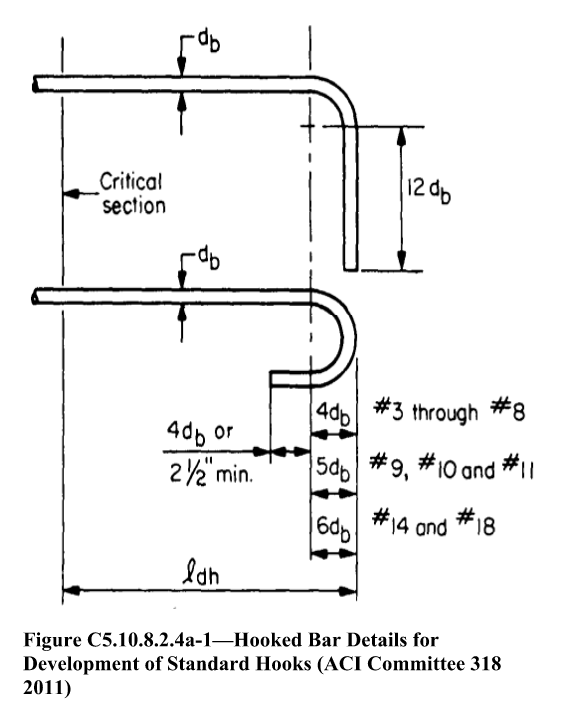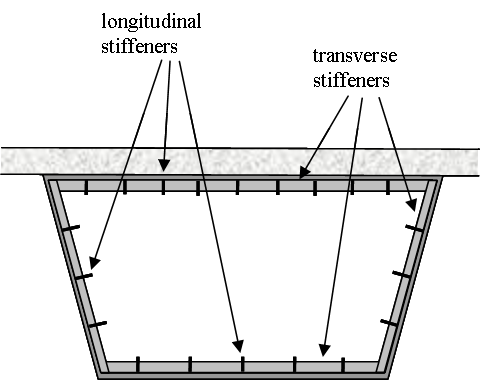-
Posts
26 -
Joined
-
Last visited
-
Days Won
3
Content Type
Profiles
Forums
Events
Everything posted by hali
-
I have not heard of this criterion. Is this in a code?
- 12 replies
-
- hooks
- reinforcement detailing
-
(and 1 more)
Tagged with:
-
I doubt anyone from the State will be available to address such minor things lol. My only remaining assumption about this would be that they used the modifier As-required/As-provided to reduce the development length. But regardless, thanks for helping me out with this. I think I'll go back to some textbook basics and see if I missed anything in there.
- 12 replies
-
- hooks
- reinforcement detailing
-
(and 1 more)
Tagged with:
-
So shouldn't the negative rebar be developed adequately into the wall? According to AASHTO's development length equation it would be about 36" straight and 9.5" hooked. It looks like it wasn't properly developed
- 12 replies
-
- hooks
- reinforcement detailing
-
(and 1 more)
Tagged with:
-
Alright guys I'm back and here's the specific problem where I'm having confusion. The following link is a State standard detailed drawing of a range of different RCB (ranging in span lengths and heights). https://www.odot.org/bridge/2009-sb/brd_std_2009-lrfd-sb-531.pdf I'm dealing with a double 6'x3' RCB. The A1 bars in the top slab are #6 bars, so their basic development length is about 14.5". Now this was not developed into the walls because I'm assuming you cast the slab last so the concrete in the walls has already matured. But shouldn't it have 180 degree hooked bars at least? Also I don't think this wall-slab connection can be considered a simply supported one since rebar is being developed from both layers from the walls.
- 12 replies
-
- hooks
- reinforcement detailing
-
(and 1 more)
Tagged with:
-
Thank you @UmarMakhzumi and @Badar (BAZ) for your responses. I'll apply these to a problem I'm dealing with at the moment. I'll probably have some more questions as well so I'll be back again lol
- 12 replies
-
- hooks
- reinforcement detailing
-
(and 1 more)
Tagged with:
-
AOA everyone. Recently I've been very confused with development length and how its provided in different components. I have a few conceptual confusions about it and then a few practical and design aspects of it. I'd really appreciate help on these. Do we provide/check development length for simply supported beams (i.e. check it past the max moment?) Where do we need to check for development length? (in my understanding, we need to check it almost everywhere, where you need to ensure full moment capacity) What is a "critical section" when we talk about development length? (refer to the attached picture) I think its the point beyond which we need to ensure development At a wall-slab joint where both the slab and wall are 8" thick, if #6 bars at 8" c/c need to be developed from the slab into the wall, I found that even with the 90 degree hook, the development length is at least 14". How do you satisfy development length in such a case? For hooked development length ldh, is it the length up to the hook or is the length that includes the length of the hook? For example for a 90 degree hook, would it be 12db+the length beyond the critical section or just the length beyond the critical section up to the hook? I've seen in a few places on the internet that people include the 12db into the development length. This stuff has been eating up gray matter from my brain for a few days now. Any help is appreciated. Thanks!
- 12 replies
-
- hooks
- reinforcement detailing
-
(and 1 more)
Tagged with:
-
AOA everyone. Recently I've been very confused with development length and how its provided in different components. I have a few conceptual confusions about it and then a few practical and design aspects of it. I'd really appreciate help on these. Do we provide/check development length for simply supported beams (i.e. check it past the max moment?) Where do we need to check for development length? (in my understanding, we need to check it almost everywhere, where you need to ensure full moment capacity) What is a "critical section" when we talk about development length? (refer to the attached picture) I think its the point beyond which we need to ensure development At a wall-slab joint where both the slab and wall are 8" thick, if #6 bars at 8" c/c need to be developed from the slab into the wall, I found that even with the 90 degree hook, the development length is at least 14". How do you satisfy development length in such a case? For hooked development length ldh, is it the length up to the hook or is the length that includes the length of the hook? For example for a 90 degree hook, would it be 12db+the length beyond the critical section or just the length beyond the critical section up to the hook? I've seen in a few places on the internet that people include the 12db into the development length. This stuff has been eating up gray matter from my brain for a few days now. Any help is appreciated. Thanks!
-
- development length
- reinforcement detailing
-
(and 2 more)
Tagged with:
-

Rules of Thumb for Providing Reinforcement in Joints
hali replied to hali's topic in Concrete Design
Thank you @Simple Structures for taking the time out to draw all that. That was very helpful. For the most part, I can figure out where where the rebars are to be provided (tension locations), its the fine detailing of the rebars that I want to get comfortable and confident at. -
AOA everyone, I have always kind of struggled to understand how exactly you provide reinforcement in joints like beam-column joints or joints of box culvert. More specifically, how to ensure transfer of moment through the joint. Does anyone have any pointers or rules of thumb for providing reinforcement in joints? Thanks!
-
Thanks @UmarMakhzumi I'll give it a read.
- 5 replies
-
- structural analysis
- structural design
-
(and 1 more)
Tagged with:
-
Thanks Simple Structures. I searched for the John Hancock Center in particular and could only find the outside dimensions, like you said, very generic. I was actually interested to see how the tube structure differs on the inside from a moment frame. And how exactly were the floor slabs cast.
- 5 replies
-
- structural analysis
- structural design
-
(and 1 more)
Tagged with:
-
AOA everyone, Hope everyone is staying safe during these troubled times. I have been looking into designs of famous structures for a few days and I was wondering if there are any websites or books that have structural designs of famous buildings like the John Hancock building for example. i wanted to recreate these structures maybe in a FEM program to understand them better. Does anyone know where i can find structural plans for these buildings? I'm guessing detailed plans wont be available but even something basic can be really helpful as well. Thanks.
- 5 replies
-
- structural analysis
- structural design
-
(and 1 more)
Tagged with:
-

Girts and Purlins affect of Column Beam Effective Length
hali replied to Salma Jabeen's topic in Steel Design
Hello everyone. Extending on Salma's questions, will the purlins be sufficient as bracing elements against lateral torsional buckling of straight simply supported beams? -

ACI Coefficient Method for Analysis of Two-Way Slabs
hali replied to hali's topic in Concrete Design
Thank you for letting me know Zain. -
AOA everyone. I just wanted to know, is the ACI coefficient method for analysis of two way slabs still valid? Or some other method is preferred over this one? Regards, HA
-
Please refer to this article by CSI on the topic. https://wiki.csiamerica.com/display/tutorials/Composite+section Also there are SAP/ETABS tutorials on YouTube regarding the same. Following is a video on YouTube. Hope this helps. Regards, HA
- 4 replies
-
- composite
- steel composite beam
-
(and 1 more)
Tagged with:
-

Pakistan Engineering Council (PEC) Elections
hali replied to UmarMakhzumi's topic in General Discussion
I checked the PEC website. They haven't provided comprehensive profiles or the candidates. Just one paragraph. -
Yes I recently discovered this too. It can be done through thickness over writes now. Thanks for your help
- 5 replies
-
- shell element
- insertion point
-
(and 1 more)
Tagged with:
-
Its usually referred to as a box girder or tub girder.
- 2 replies
-
- bridge
- stiffeneres
-
(and 1 more)
Tagged with:
-
Salam everyone, I doing some research on stiffened box girder bridges but I'm having some trouble finding the right one. If anyone has access to some papers or textbook examples or a bridge they designed it would really help me out. Specifically I'm looking for a steel box girder bridge (trapezoidal or rectangular) that has its flanges and/or webs stiffened with welded longitudinal stiffeners. More than one stiffener is preferred (refer to attached image). I need the cross-sectional dimensions and stiffener dimensions too if possible. I have attached a few images as reference. Thank you for your time and help in advance.
- 2 replies
-
- bridge
- stiffeneres
-
(and 1 more)
Tagged with:
-
I followed these points but there is no "Shell" under the Assign menu. I'm using SAP version 19. Is it possible they changed it? I can't find the cardinal points or insertion points anywhere for shells/plates.
- 5 replies
-
- shell element
- insertion point
-
(and 1 more)
Tagged with:
-
Thank you Ayesha this will help!
- 5 replies
-
- shell element
- insertion point
-
(and 1 more)
Tagged with:
-
Salam everyone. Does anyone know if you can modify insertion points for shell elements in SAP 2000? Regards, Haider Ali
- 5 replies
-
- shell element
- insertion point
-
(and 1 more)
Tagged with:
-
Salam everyone. I'm doing a study for fatigue crack growth in a steel box girder bridge. For that I need the loading history (or strain history). If anyone can share it, it would be greatly appreciated. Regards, Haider Ali
-

Interpretation of M11 forces in masonry shell walls in ETABS
hali replied to dipesh joshi's topic in General Discussion
Thanks Umar this will help (y)




